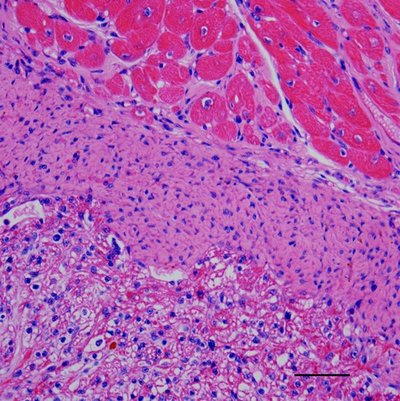August 27, 2007
Human derived stem cells can repair rat hearts damaged by heart attack
When human heart muscle cells derived from embryonic stem cells are implanted into a rat after a heart attack, they can help rebuild the animal’s heart muscle and improve function of the organ, scientists report in the September issue of Nature Biotechnology. The researchers also developed a new process that greatly improves how stem cells are turned into heart muscle cells and then survive after being implanted in the damaged rat heart. The findings suggest that stem-cell-based treatments might one day help people suffering from heart disease, the leading cause of death in most of the world.
The study was conducted by researchers at the University of Washington School of Medicine in Seattle and at Geron Corp. in Menlo Park, Calif. The scientists set out to tackle two of the main challenges to treating damaged hearts with stem cells: the creation of cardiac cells from embryonic stem cells, and the survival of those cells once they are implanted in a damaged heart.
“Past attempts at treating infarcted hearts with stem cells have shown promise, but they have really been hampered by these challenges,” explained Dr. Chuck Murry, director of the Center for Cardiovascular Biology in the UW Institute for Stem Cell and Regenerative Medicine, and corresponding author on the study. “This method we developed goes a long way towards solving both of those problems. We got stem cells to differentiate into mostly cardiac muscle cells, and then got those cardiac cells to survive and thrive in the damaged rat heart.”
Embryonic stem cells can differentiate, or turn into, any type of cell found in the body. But researchers had struggled to get stem cells to differentiate into just cardiomyocytes, or heart muscle cells — most previous efforts resulted in cell preparations in which only a fraction of 1 percent of the differentiated cells were cardiac muscle cells. By treating the stem cells with two growth factors, or growth-encouraging proteins, and then purifying the cells, they were able to turn about 90 percent of stem cells into cardiomyocytes.
The researchers dealt with the other big challenge of stem cell death by implanting the cells along with a cocktail of compounds aimed at helping them grow. The cocktail included a growth “matrix”– a sort of scaffolding for the cells to latch on to as they grow — and drugs that block processes related to cell death. When using the pro-growth cocktail, the success rate of heart muscle grafts improved drastically: 100 percent of rat hearts showed successful tissue grafts, compared to only 18 percent in grafts without the cocktail.
“The problem of cell death is pretty common in stem-cell treatments,” Murry explained. “When we try to regenerate with liquid tissues, like blood or bone marrow, we’re pretty good at it, but we haven’t been very successful with solid tissues like skeletal muscle, brain tissue, or heart muscle. This is one of the most successful attempts so far using cells to repair solid tissues — every one of the treated hearts had a well-developed tissue graft.”
When the researchers followed up on the stem-cell treatment by taking images of the rat hearts, they found that the grafts helped thicken the walls that normally stretch out after a heart attack and cause the heart to weaken. The thickened walls were also associated with more vigorous contraction.
“We found that the grafts didn’t just survive in the rat hearts — they also helped improve the function of the damaged heart,” said Dr. Michael Laflamme, UW assistant professor of pathology and the lead author of the study. “That’s very important, because one of the major problems for people suffering a myocardial infarction is that the heart is damaged and doesn’t pump blood nearly as well. This sort of treatment could help the heart rebound from an infarction and retain more of its function afterwards.”
The next step in studying stem-cell treatments for the heart is to conduct similar experiments in large animals, like pigs or sheep, while further refining the treatment in rats. Early human clinical trials could begin in about two years, Murry said.
###


